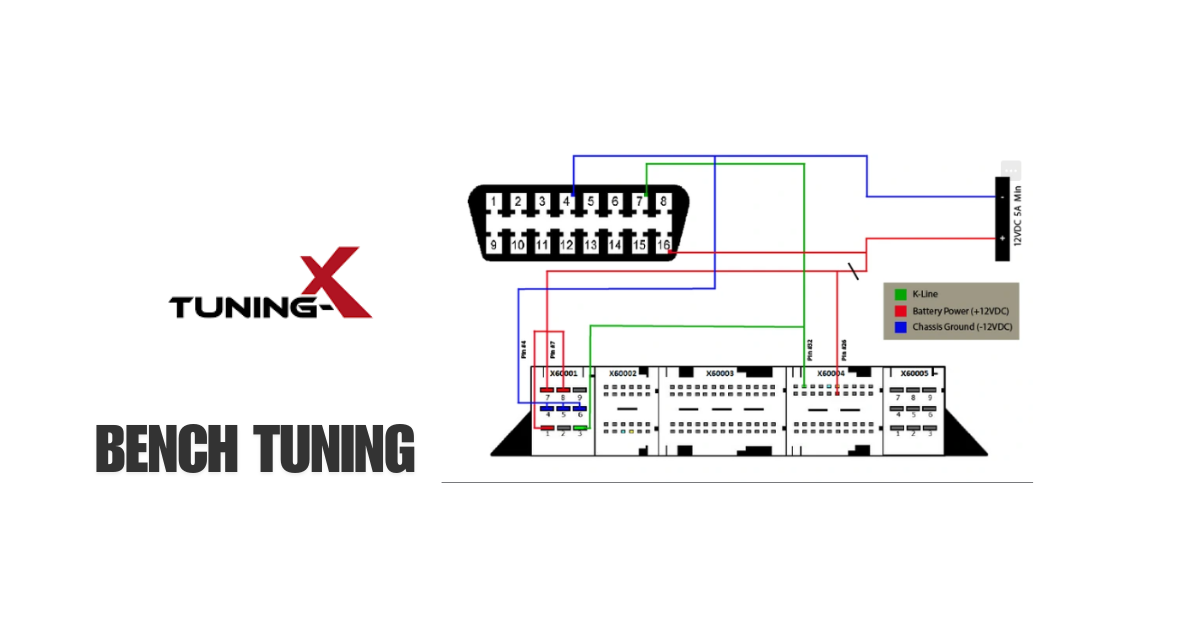Bench Tuning – Techniques and Tools Explained
With the term Bench tuning, we refer to an advanced ECU (Engine Control Unit) remapping method, in which removing the ECU from a vehicle is necessary after it is connected directly to the pins that the car’s wiring plugs into.
In order to perform this method, tuners need external power to power up the ECU and a boot cable. Tuners connect multiple pins to power and grounding and all the other needed communication interfaces like CAN+ and CAN- or Kline in order to read and write data to the ECU.
With this reading mode, the entire memory storage of the ECU can be read, and full access to all ECU data is achieved, providing a direct and easy method of reading all the ECU’s data and settings. This technique is ideal for vehicles where OBD port remapping is restricted by the manufacturer.
Unlike OBD tuning, which modifies ECU parameters through the vehicle’s diagnostic port, bench tuning requires direct removal of the ECU from the vehicle, provides greater customization and enables tuners to unlock the full potential of an engine.
When is Bench Tuning Necessary?
Why should a tuner choose to go through a bench tuning mode? When OBD port tuning is blocked by manufacturer restrictions. A lot of manufacturers have restrictions on the amount of data a tuner can extract from the OBD port, making the bench mode tuning one-way since with bench mode tuners can extract all ECU’s data.
Also, a lot of times when tuners need a deeper ECU modification in order to achieve greater performance optimization, they follow the bench tuning mode.
Advantages and Considerations of Bench Tuning.
In order to discover the advantages and realize all the considerations that tuners face on bench tuning, we must see all the Bench Tuning process step-by-step.
Bench Tuning Process:
- ECU Removal:The vehicle’s ECU is carefully disconnected to prevent damage to connectors and wiring.
- Tuning Tool connection:The tuning tool is connected to the ECU’s power and communication pins according to the tool’s diagram instructions
- Reading Data:The tuner reads the ECU’s original software and backs it up to prevent data loss.
- Modifying the ECU Parameters:The tuning software is used to adjust performance settings like fuel injection, ignition timing, and boost pressure according to the tuning goals and expectations.
- Flashing and Reinstalling the ECU:The modified data are written back to the ECU, and the ECU is carefully reinstalled in the vehicle.
Tools needed for Bench Tuning:
Let’s see some of the top ECU tuning tools for Bench Mode.
- Magic Motorsport Flex: Known for its power, versatility and reliability, it is a great option for professional chiptuning file services.
- Alientech KESS3: The successor of KESSV2 and K-TAG devices, known for its flexibility, performance and ease of use. Adaptable to any tuners demands and tuning goals.
- Autotuner: An efficient ECU programming tool with extreme fast data transfer speeds and broad vehicle compatibility. It ensures safe and reliable ECU flashing without soldering.
How to Choose the Right Tuning Method?
What is the best method for extracting data from a vehicle’s ECU in order to go through a tuning process? To answer this question, various factors like the modification level, tuning goals, tuners knowledge and available tools must be taken into serious consideration.
Every tuning method has its advantages and place in the tuning industry. Of course, in certain cases, there are some disadvantages of remapping and tuning,
OBD reading is considered the simplest, fastest and less invasive approach, but the security and protection are lower than the security and protection that are provided by bench reading.
The boot mode, even though it is not as secure as bench mode, can be used to unlock locked ECUs.
Below is a table with the basic characteristics of its method:
| Tuning Method | Customization Level | Invasiveness | Best For |
| OBD Tuning | Medium | Low | Quick & simple remaps |
| Bench Tuning | High | Medium | Performance-focused tuning |
| Boot Mode Tuning | Maximum | High | Unlocking locked ECUs |
You should also check out the BDM Tuning method which also provides maximum customization!
FAQs for Bench Tuning
What is Bench Tuning Mode, and how does it differ from OBD Tuning mode?
Bench Tuning is a simple ECU remapping method that allows you to read the complete ECU data without having to open it; simply physically remove it from the vehicle and connect only the power and data signal wires on the ECU connector (pinout). This method allows tuners to achieve deeper customization and access to ECUs that may be restricted through OBD. In contrast, OBD tuning is done via the car’s diagnostic port, offering a quicker but sometimes more limited tuning option.
Is Bench Tuning mode safe for my ECU?
A common question among vehicle owners is the level of security that is provided through the Bench Tuning. The answer is YES, when it is performed correctly using professional tools like Autotuner, Alientech KESS3 or Alientech KESS3, it is completely safe. But it must always be done by professional, experienced and well-trained tuners like Tuning-X to avoid any risk of damage.
What are the benefits of Bench Tuning over Boot Tuning mode?
As already mentioned, Bench Tuning mode is less invasive as it simply requires to physically remove the ECU but not open it, like Boot Tuning; for the same reason, it is faster and more secure.
Conclusion on Bench Tuning mode
Bench Tuning mode offers a lot of benefits and extreme security; a tuner must choose if he decides to use this method according to the knowledge, tools and goals his vehicle tuning plan has. An increase in power, a greater fuel efficiency, and a driving customization can be achieved through Bench tuning mode.


